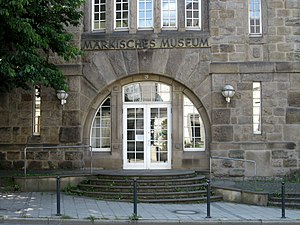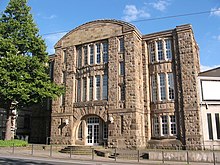Märkisches Museum (Witten)
 Entrance to the Märkisches Museum Witten, June 2008 |
|
| Data | |
|---|---|
| place | Witten |
| Art | |
| architect | Carl Franzen |
| opening | 1911 |
| operator |
Kulturforum Witten ( AÖR of the city of Witten )
|
| management |
Christoph Kohl
|
| Website | |
| ISIL | DE-MUS-176216 |
The Märkisches Museum Witten is a museum in Witten . It mainly presents modern German painting.
history


The Märkisches Museum was founded by the Association for Local and Local History in the Grafschaft Mark (VOHM) in 1886 as an industrial, commercial and assembly history, overall as a historical local museum . After three provisional locations, the VOHM built the Märkisches Museum on today's Husemannstrasse from 1909 to 1911 with the help of a foundation from the factory owner Friedrich Lohmann . The museum united paleontological , geological , mineralogical , biological and cultural-historical collections (the latter included the Engelbert statue and the Strünkede tomb). A commercial and industrial history collection did not succeed. An extensive library on local history and the history of Westphalia , on legal , church and medical history has been added to the collections. The archive then became an essential part of the collections (including the oldest documents on the history of Witten and the newspaper history of the region). A collection of coins and medals was added later (German (spiritual) territories before 1800, medals on the subjects of Otto von Bismarck , aviation , Christine von Braunschweig , wife of Emperor Charles VI. ). Until the 1920s, art was only collected to the extent that it was related to the region and documented historical conditions. Art exhibitions that went beyond this were usually designed as sales exhibitions, through which the association, as the sponsor of the museum, earned through commissions and thus sought additional financing
Peter Emil Noelle , then director of the Wittener Ruhr-Gymnasium and chairman of the VOHM , moved the focus of the collection to modern German painting as museum director. However, when the star of Reich Propaganda Minister Joseph Goebbels , who had patronized certain representatives of Expressionism , began to decline in 1937 and the party ideologist Alfred Rosenberg prevailed over him, Noelle's position in Witten became untenable despite his National Socialist convictions. He had bet on the Goebbels direction. The National Socialists then relied on a historical museum that worked in their favor, but this direction did not develop due to the war. In 1944, the then "club leader", Lord Mayor Karl-August Wietfeld, transferred the Märkische Museum belonging to the VOHM together with the collections of the city of Witten.
Wilhelm Nettmann , director of the museum from 1953 to 1978, continued work in the field of modern art. During his tenure, the museum was expanded to include the neighboring Villa Berger , which today houses the Kulturforum Witten .
Under the successor Wolfgang Zemter , head of the house from 1978 to 2009, the museum was closed, restored and significantly expanded from 1985 to 1988. The principle of openly conceived rooms was adopted in order to continue the dialogical structure of the collection presentation with contemporary means.
In October 2014, the construction of an extension for the Witten library began . In 2016 the Witten library moved into this extension.
architecture
The Märkisches Museum was built as a concrete building according to plans by Carl Franzen . The facade made of Ruhr sandstone was supposed to give the impression of massive masonry. The floor plan is based on that of a three-aisled church. The museum has been listed as an architectural monument in the city's list of monuments since 1984 .
collection
In line with its founding tradition, the focus of the collection was initially on cultural and historical goods from the area of Grafschaft Mark , which had been collected by the Association for Local and Local History in Grafschaft Mark. When ownership was transferred to the city of Witten, large parts of this collection became the property of the city. In addition to the statue of Archbishop Engelbert I of Cologne (around 1230, currently on loan to the permanent exhibition of the Ruhr Museum Essen), this also includes the tomb of the Strünkede family (so-called Strünkede group, 16th century), which are still the most important art objects in the collection.
The core of the art history collection is made up of around “4,000 paintings, sculptures and graphics” from modern painting of the 20th century in Germany. The museum has works by various important expressionists , including paintings by Max Pechstein , Ernst Ludwig Kirchner , Emil Nolde , Erich Heckel , Conrad Felixmüller , August Macke , Gabriele Münter and Heinrich Campendonk . The Westphalian expressionists Wilhelm Morgner and Christian Rohlfs are of particular interest .
The collection also focuses on New Objectivity (including works by Eberhard Viegener , Josef Wedewer and Elisabeth Schmitz ) and Critical Realism (including works by Rissa , Wolfgang Petrick , Hans-Jürgen Diehl , Maina-Miriam Munsky , Lambert Maria Wintersberger , Peter Sorge , Konrad Klapheck , Bruno Goller ).
According to its own information, the museum also houses the largest collection of German Informel .
Temporary exhibitions (selection)
- 2010
- Fabian Weinecke : Night work
- Sven Drühl , Catalina Pabón, Tanja Rochelmeyer, Jens Wolf: Mixed
- 2011
- Dirk Hupe : Listings | Spaces
- 2012
- Charles Wilp : The Power of Images
- Kirsten Krüger : Rough terrains
- 2013
- Gustav Deppe : Departure between abstraction and figuration
- 2014
- Sonja Alhäuser , Anne Amelang, Kristina Berning, Luka Fineisen , Andreas Fischer, Daiga Grantina, Vera Lossau , Jochen Mühlenbrink , Marten Schech, Dirk Stewen : Boesner Art Award 2014
- 2015
- Christoph Dettmeier : Journey to the end of the night
- 2016
- Michael Jäger : Michael Jäger - Whiz Bang
- Liberated modernity . Art in Germany 1945 to 1949
- 2017
- Friederich Werthmann on his 90th birthday: steel. Poetry. dynamics
- Josef Albers , Bernd Damke , Rupprecht Geiger , Ernst Hermanns , Harald Kahl, Alf Schuler , Susanne Stähli , Günter Stangelmayer, AD Trantenroth , Rudolf Vombek : concrete! Form and color relationships in area and space
- 2018

- Alexander Chekmenev, Clemens Botho Goldbach, Olaf Metzel : On ascent and descent (as part of the "Art & Coal" project of the RuhrKunstMuseen )
- Presentation of the Gustav Deppe collection . Exhibitions on the gallery
- Stephan Baumkötter, Sebastian Dannenberg, Caroline von Grone, Marta Guisande, Evelina Velkaite, Stefan à Wengen : possibilities of painting
- The artist group “young west” 1947–1962 . Exhibition to mark the 70th anniversary of the artist group Junge westen
literature
- Wilhelm Nettmann: How it all started. 1886-1976. 90 years association for local and local history in the county of Mark zu Witten and the Märkisches Museum of the city of Witten . In: Yearbook of the association for local and local history in the county of Mark . tape 74 , 1976.
- Heinrich Schoppmeyer : The foundation stone for the Märkisches Museum was laid one hundred years ago on May 18, 1909 . In: Märkisches Jahrbuch für Geschichte . tape 110 , 2010.
- Association of West German Reinforced Concrete Enterprises (ed.): Building executions of the members . Düsseldorf 1909.
- Dagmar Drebusch: The Märkisches Museum under Peter Emil Noelle, 1946 to 1953 (= contributions to the history of the Märkisches Museum in the city of Witten . Volume 1 ). Märkisches Museum, Witten 1986.
- Wolfgang Zemter: The Märkisches Museum under Wilhelm Nettmann 1953 to 1978 (= contributions to the history of the Märkisches Museum in Witten . Volume 2 ). Märkisches Museum, Witten 1995.
- Ralph Klein: The Märkisches Museum in Witten under the direction of PE Noelle from 1930 to 1937 . In: Yearbook of the association for local and local history in the county of Mark . tape 112 . Dortmund 2012, p. 170-208 .
Web links
Individual evidence
- ↑ a b Märkisches Museum Witten. Retrieved September 14, 2018 .
- ↑ a b Dieter Schidt: The year 1911. VOHM, archived from the original on June 3, 2017 ; accessed on September 14, 2018 .
- ↑ a b Information on the collection on the museum's website at the Kulturforum Witten
- ^ Märkisches Museum Witten: exhibitions . Retrieved May 12, 2018
Coordinates: 51 ° 26 ′ 4.6 ″ N , 7 ° 20 ′ 18.6 ″ E

